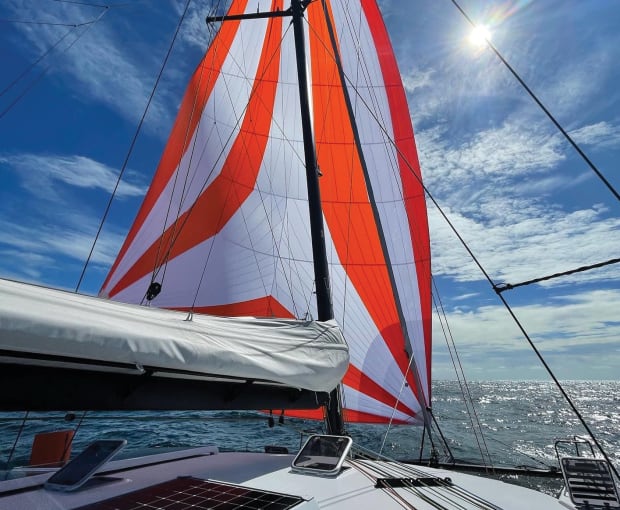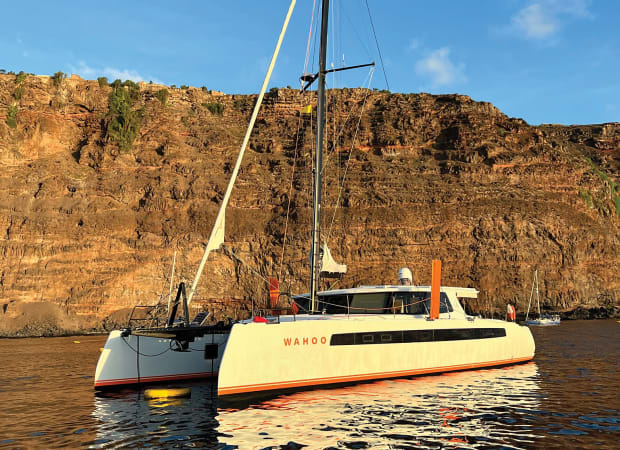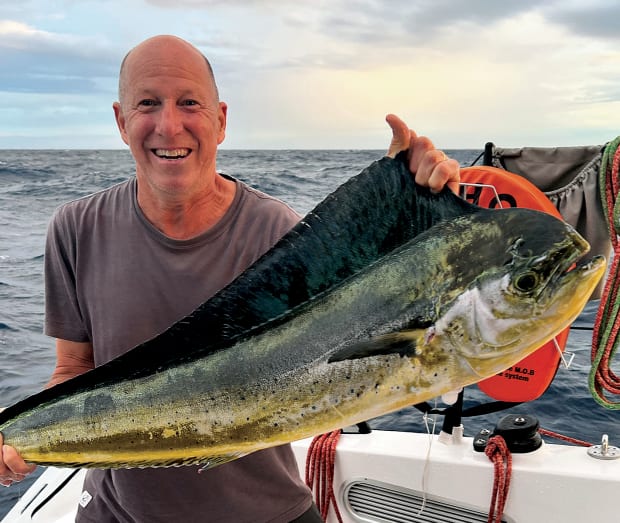
Photo courtesy of David and Alison Lennarz
Most sailors take months or more to learn a new boat since, truth is, most of us have limited or sporadic time to devote to the education. David and Alison Lennarz, on the other hand, put their learning curve on fast-track mode when they took delivery of their new Balance 526 in St. Francis, South Africa, and made a 6,500-nautical-mile, midsummer transatlantic to Grenada as their shakedown passage.
It was an eye-opening voyage on many levels for the Virginia couple, both lifelong sailors whose previous boats had included a Melonseed skiff, a Pearson 33, and, most recently, a 26-foot Herreshoff Alerion, which they still sail in the Chesapeake Bay. Making 20 knots under a scrap of storm jib in the Atlantic, essentially surfing on a 52-foot surfboard, was a helluva long way from weekend trips with the kids out of Fishing Bay Yacht Club in Deltaville, Virginia, or even chartering a multihull to try them on for size in the Caribbean.

Photo courtesy of David and Alison Lennarz
“It was 28 sailing days, and we were gone almost exactly two months,” Alison says. They averaged about 230 miles a day, sailing with David’s brother, Matt, and a professional captain who had done the trip multiple times. After leaving St. Francis on June 9, 2022, they made brief stopovers in Cape Town, St. Helena Island, and Fernando de Noronha (an island off Brazil) before arriving in Grenada on July 22.
“So, yeah, it was a lot of miles,” David laughs, “but we definitely know the boat better!”
Both grew up sailing. When she was 14, Alison’s uncle bought her cousin a 420, and she crewed for her for two years. A Baltimore native, David grew up sailing the Chesapeake on a Columbia 31, and he fell in love with big-boat sailing as a teenager in Florida. The two met as members of the University of Virginia’s (UVA) sailing association. Eventually, they worked for Sail Caribbean teaching sailing, lived in St. Barths for a few years and then Paris (Alison is a dual citizen), and finally landed in Gloucester, Virginia.
“Of course, we wanted a boat,” Alison says. They bought a Pearson 33 from another yacht club member. “I think we paid $50,000 and financed most of it. It was called Corrosol, which was the name of a town where we lived in St. Barths. It’s the French word for breadfruit. We had it about five years and then we sold it because the kids were very involved in junior sailing, we were very involved in running the junior sailing program, and we didn’t have any time to sail. We were following them around in their little Optis.”
Alison is a trust and estates lawyer. David and a UVA friend founded a business that helps companies navigate Food and Drug Administration compliance. When David sold some of his company, they had money to invest, and after ruling out a house in the Caribbean, they landed on the idea of a performance catamaran. After learning about Balance Catamarans and talking with the company’s founder, Phil Berman, they made their choice.
“It sort of ticked the boxes, from comfort, performance, looks good for a cat, size was right,” David says. “And what also attracted us to the Balance, other than performance and how it looks as a catamaran, are the redundancies and the thought process that went into building it.”
“We wanted a boat that we could have friends and family on because we’re actually pretty social,” Alison adds. “My mom is still pretty fit, and I didn’t want to have to abandon her every time we went on vacation…so our intention is to invite all the people we love to come sail with us.”
The new boat, called Wahoo (the UVA mascot and also a fast fish), was unquestionably a giant leap in their sailing experience in just about every way, from speed and handling to sailplan, gear, equipment (like a watermaker), electronics, and even rigging materials, like Dyneema soft shackles rather than the old-school versions they were used to. Though they’d both sailed all their lives and had made multiple trips across the Gulf Stream, this was a new world.

Photo courtesy of David and Alison Lennarz
“Obviously we did a ton of planning around equipment and first aid,” David says. “I did a NOLS course. My brother is an ER doctor, so we had him if we had to dial into someone and be in communication.” They both attended cruising classes and gathered as much information as they could.
“It still felt like we could have done more,” Alison says. “There are still things I wanted to do and study.”
Some last-minute delays at the factory and the timing pressure of the oncoming hurricane season meant they didn’t get as many sea trials as they’d hoped before leaving. One of Alison’s least pleasant surprises was how seasick she initially became at the starts of the first two legs, both of which were really snotty.
Still, she says, she wouldn’t trade the trip from St. Francis around Cape Agulhas, despite the rough going. “Sailing around that southern coast of South Africa is absolutely magnificent,” she says. “It was honestly one of my favorite parts of the whole trip. Seeing the seals and the whales spouting and the really rough coastline that’s undeveloped for so much of it, the large kelp beds…”
The eight days from Cape Town to St. Helena were “big seas, big wind the whole way,” David says, “basically a broad reach, and occasionally we had to jibe. Thirty knots of wind, we had a 60-knot squall, 20-foot seas. It basically never stopped, just constant the whole time.”
One of the biggest adjustments, he says, was how loud the boat was in those conditions. Wahoo is carbon—a material known for making a noisy boat whether a multihull or monohull—with an aluminum mast and Dyneema standing rigging coated in a UV and chafe-guard material. David says in those conditions, the “force of the waves going between the hulls is deafening…you could literally know when we were breaking 15 knots—we hit 26.4 knots, granted it was surfing down a wave—but the daggerboards would hum, the shrouds would buzz.”
Phil Berman notes that slowing down would have done much to ameliorate the noise they were experiencing. “I tell people when they order our XP carbon hulls that when sailing very fast like Wahoo it will always be louder than our standard e-glass hulls,” he says. “E-glass is more flexible, whereas carbon is rigid, has no give, so when the boat is really flying she becomes like a drum. The good news is that you can take in a reef, go from 18 to 12 knots, and she becomes much quieter. At 12 knots the world grows calmer and she is still much faster than the typical catamaran.”
The boat’s performance and handling in those conditions also reassured David and Alison that they’d chosen well. Wahoo was fast and rock solid.
“It gave me confidence in the boat because it took so much pounding,” Alison says. “And it also made me appreciate why you wouldn’t want to take just any old boat out in those kinds of conditions.”

Photo courtesy of David and Alison Lennarz
David’s brother Matt, who was writing a brief daily email to friends and family, summed it up in a June 23 missive titled “Loud Night.”
“The advantages of a cat are clear…the stability is of course the main one. You can’t set an open cup of tea on any surface in a mono without losing it in gale force winds with breaking 10-foot seas. Our drinks stay in place and don’t even slosh over. Making meals, showering, cleaning, sail changes, etc., all are a little easier. Next, the common space is very comfortable…no one is out in a cockpit alone. We all can be together in the main saloon while watching our sails, the nav systems, and a view of our surroundings…especially nice in heavy weather. And the performance is unbeatable. While one of the biggest complaints of a cat is the pointing ability, this performance model can point as high as any cruising monohull while hitting 20-plus knots. So…in summary, Wahoo is noisy in heavy seas, but is a stable, comfortable, high-performing cruising machine.”
Though their captain had assured them that leg 3 from St. Helena Island to Brazil’s coast would be lighter, it didn’t happen. They still were racing along in 30 knots of wind.
“We never got to fish on those legs because we were always going too fast,” David laughs. At some point, though, he says he realized: “Not that I ever would have wanted to do that [trip] on our own, but I definitely felt partway through, I’m like, OK, I can do this…I learned the boat and felt confident with it.”
Everything on Wahoo was bigger by an exponential factor, Alison says, and at first, she was intimidated by it. But over the miles, she, too, gained confidence as she learned. “I was a little anxious about not knowing how to do everything,” she says. “And so now, I feel better.”
They spent two nights and three days in the UNESCO World Heritage Site of Fernando de Noronha, Brazil, enjoying some diving, great restaurants, and the energetic vibe of the community, before setting off on the last, longest leg to Grenada. They marveled at how far offshore they could see the Amazon River’s muddy influence, and they crossed the equator with the applicable pomp, champagne, and ceremony. On this leg, seas and wind finally settled down—in fact died completely in the Doldrums—and they caught fish and enjoyed warm sunshine.
“Finally we hit the trade winds this morning, and it slowly picked up to 25 knots,” Matt wrote on July 21. “Thank God because our diesel is running low (even with six extra jerry cans). We’ve been flying under a single-reefed main and jib all day and hitting 12-14 knots boat speed.”
They finished the voyage the next day.
“We shot right past Trinidad and Tobago and rolled into Grenada and got the boat ready to haul,” David says, just in time for hurricane season.
From here, David and Alison say they hope to sail Wahoo in chunks of time they can carve away from their work. And with all they learned on the transatlantic shakedown, distance sailing is certainly part of the plan.
“My vision,” Alison says, “is to sail the Caribbean, especially islands we haven’t spent much time in, then the Bahamas, and then up as far north as we can to get over to the British Isles, to the the Med, Croatia. And then we’ll see what happens.”
May 2023








